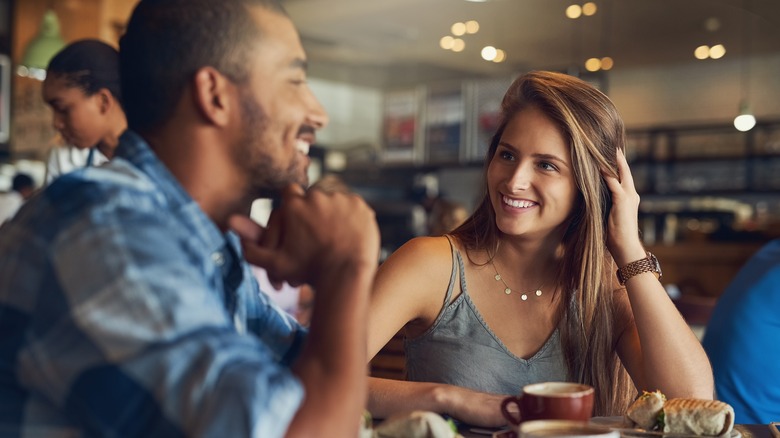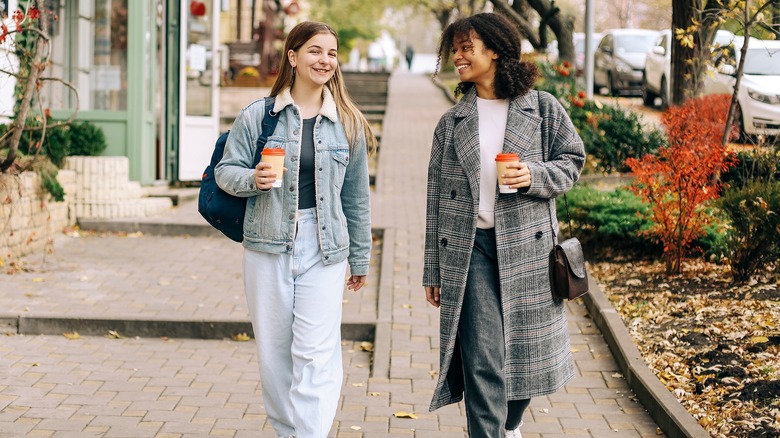Tiktok's Viral Relationship 'Gap Theory,' Explained
They say first impressions matter most, but that might not be entirely true. Sometimes, we make assumptions about people that later turn out to be inaccurate — that is if we're willing to let ourselves see the truth. The TikTok-viral "gap theory" touches on this exact point.
FYI, there's more than one meaning behind the phrase "gap theory" on the social media platform, but this particular concept focuses on relationships and how we choose to view others (and let others view us). Justine Doiron, a recipe developer and content creator, coined the term in a popular clip boasting over 92,000 likes to date.
Essentially, Doiron's theory says that there are knowledge "gaps" we have about others, and how we choose to fill those holes makes all the difference when forming an opinion about someone — for better or worse. As she notes in her video, "It's easier to like somebody on a first date than it is on a fifth date." So what does this all mean for you and your relationships? Here's what you need to know.
The gap theory says first impressions can be misleading
Think about the last time you met someone new. Maybe it was your first time meeting a dating app match in real life, or it might've been a friend of a friend at a party. No matter who it was, you probably had only limited information about them as a person. The parts you hadn't yet discovered are the "gaps" in Justine Doiron's gap theory. In many cases, she suggests, people fill those gaps with their own, often idealized assumptions. Do you like clubbing and want a Friday night dance partner? You might assume a new friend likes clubbing too, even if they never mentioned it. Feeling emotionally ready for a relationship? You'll probably believe the cutie who gave you their number is too, according to the gap theory.
The best way to cope with this tendency, Doiron explains, is to fill the gaps with honest, factual realizations about others because it's "harder to fall in love with somebody when there are those gaps." This involves asking tough questions at times and facing who someone truly is, rather than merely seeing them as the person you want them to be.
The video also mentions the importance of self-disclosure to help others accurately fill the gaps they have about you, though the creator admits this can feel vulnerable and may put you at risk of being rejected by those who can't appreciate the real you.
The psychology behind the gap theory
Doiron may not be a psychologist or relationship expert, but her gap theory is definitely onto something. The truth is we're all a little guilty of seeing what we want to see and blocking out (at least some of) the rest. This "motivated perception" phenomenon can occur in relationships, as well as in other situations, and there's a name for it, according to a 2019 study published in the journal Nature Human Behavior. Researchers found that participants tended to "see" the images they wanted to see during a visual experiment, whether they were the actual images presented or not.
This is a type of selective perception, where the brain only focuses on a limited amount of stimuli. This can pose a problem when crafting judgments about others. Just as Doiron discusses on TikTok, people become fond of new friends and partners based on their projections of each other. That might mean overlooking huge red flags or a bad gut feeling to uphold a favorable image of someone.
Only reinforcing these early relationship assumptions is something called the primary effect, a tendency to remember early information and first impressions better than recent information. "Our brains are very reluctant to change an impression once it's formed," psychologist Heidi Grant Halvorson told Forbes. However, the more aware you are of the gap theory — and the psychology behind it — the easier it is to question your assumptions and start seeing people as they really are.


